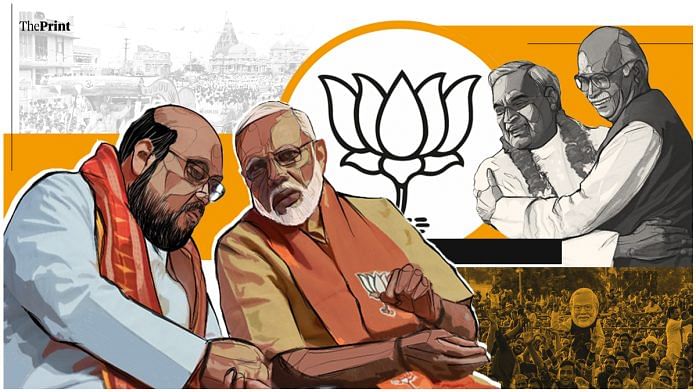Forty years ago, Atal Bihari Vajpayee and L.K. Advani founded the Bharatiya Janata Party. Today it is led by the duo of Narendra Modi and Amit Shah, who have won two general elections with full majority. Under Modi-Shah, BJP has seen centralisation of power and a rise in the influence of RSS over the party. On Monday, Modi appealed BJP workers to help those in need, reaffirm the importance of social distancing and make India Covid-19-free.
ThePrint asks: How is Modi’s BJP different from the one founded by Advani-Vajpayee 40 years ago?
BJP still ideologically close to its roots. But there has never been a formal link between RSS and BJP
 Syed Shahnawaz Hussain
Syed Shahnawaz Hussain
BJP leader and former union minister
The Bharatiya Janata Party of today is still ideologically close to its roots from 40 years ago. However, it has grown significantly on the national scale and currently has around 18 crore members. What started as a small organisation has now become a mighty tree.
Narendra Modi has successfully taken forward the dream that BJP’s founders — L.K. Advani, Atal Bihari Vajpayee — had for the country. He has also taken forward the dreams of Bharatiya Jana Sangh leaders Deen Dayal Upadhyay and S.P. Mookerjee. Earlier, party leaders had the trust of the party members, but Modi has helped the party gain the trust of the entire nation.
On the question of RSS’ involvement during the course of the party’s growth, I can assure you that there was never a formal link between the two. Though there have been many BJP members with an RSS background, the RSS is a separate organisation engaged more in social work than hard politics. It does not interfere in the BJP’s day-to-day functioning.
Ideology is perhaps the only place where the RSS and BJP overlaps. For example, RSS leader Mohan Bhagwat once said in his three-day lecture that “India” refers to the 1.3 billion people who are a part of the Hindu society. Modi has echoed this line with his election slogan “sabka saath sabka vishwas”.
Modi-Shah same as Vajpayee-Advani, will do anything to gain power
 Shivam Vij
Shivam Vij
Contributing editor, ThePrint
The BJP of Modi-Shah is built on the foundations of the party created ground up by Atal Bihari Vajpayee and L.K. Advani. It is tempting to count how different the party looks between that era and now, but the similarities are greater than the differences.
Starting with the party’s founding in 1980 (with Vajpayee as its first president), they experimented with periods of moderation and hardline Hindutva to expand their base and gain political power. It was a mass agitation, the Ram Janmabhoomi movement that finally took them across the river.
Modi is the master of mass politics; his winning campaign for power in 2014 was no less than the Ram Janmabhoomi movement in terms of scale. But it was a campaign where he was moderating his hardline Hindutva image by using development or vikas. Modi alternates between Hindutva and development to keep core voters happy and yet gain on-core non-Hindutva voters through the Modi personality cult.
Vajpayee had the moderate mukhauta, and Advani was the hardliner. In the case of Modi-Shah, Modi takes the governance mantle whereas Shah is the Hindutva icon.
The BJP of Vajpayee-Advani was sure of its ideological purpose but willing to make tactical short-term compromises for power. The duo of Modi-Shah isn’t very different from that. They will do anything to gain power, and then use it to further the party’s ideological agenda.
BJP under Modi is flexible, opened doors for rebel leaders from other parties
 Arun Anand
Arun Anand
CEO, Indraprastha Vishwa Samvad Kendra and author, Know About RSS
BJP has evolved into one of the most formidable electoral machines in recent times under the leadership of Prime Minister Narendra Modi. It has won two consecutive terms with full majority at the Centre and except a couple of southern states, it has expanded its footprint pan-India.
Under Modi, the BJP has expanded to new states such as West Bengal, Assam and states of northeast India. The party has also regained the political space in the state of Uttar Pradesh. It has consolidated its position in the Hindi heartland.
Modi’s BJP is different from the party led by his predecessors as it has displayed greater ideological flexibility and pragmatism. It has opened doors for leaders from other parties and is ready to stitch alliances with ‘rebels’ if it helps them form a government in that particular state.
One of the key factors which differentiates BJP under Modi from the BJP under Advani-Vajpayee is the extensive use of technology and social media as a political tool. The BJP is far ahead of its political rivals in this aspect and this has happened because of Modi’s inclination to use the most updated technology and he has been able to instill this instinct in the party leaders and cadres belonging to all levels of political hierarchy.
Vajpayee’s democratic spirit and Advani’s leadership making skills absent from BJP of Modi-Shah
 Smita Gupta
Smita Gupta
Journalist and political commentator
The foundation of the power, which the Narendra Modi’s BJP wields today was laid by Atal Bihari Vajpayee and L.K. Advani. The Vajpayee-Advani duo ran the party in a democratic fashion whereas today, Modi runs a two-man show, along with the Home Minister Amit Shah. There are three major differences between the BJP under Vajpayee-Advani and the one under Modi-Shah. Firstly, Vajpayee’s democratic spirit extended to the way he treated both political allies when the BJP came to power in 1998 as the head of the NDA, as well as the opponents in Parliament.
Secondly, Advani assiduously created a second generation of leaders that included Modi, Pramod Mahajan, Arun Jaitley, Sushma Swaraj, Manohar Parrikar, M Venkaiah Naidu and Rajnath Singh, many of whom went on to either join the Union cabinet or serve as the chief ministers. Today, the chief ministers selected by the Modi-Shah duo are ciphers, barring Uttar Pradesh’s Yogi Adityanath and Madhya Pradesh’s Shivraj Singh Chauhan who has made a comeback. Most other chief ministers are the Prime Minister’s envoys in their respective states rather than leaders in the way Kalyan Singh or Vasundhara Raje were. Similarly, the current crop of cabinet ministers — except for Shah — have very few powers, and are often not included even in key decisions of the Centre.
And lastly, the BJP and its leaders made an enormous effort to interact with the media in its formative years and that continued till the advent of Modi.
Now, the one-way communication that happens in the Modi government also characterises the BJP under Narendra Modi.
Of course, the party has never been as strong as it is today, allowing Modi to wield the sort of power that the party’s founders could only have dreamt of. But temperamentally, too — something he demonstrated even when he was the chief minister of Gujarat, ensuring that he was not sacked after the riots in 2002 — he has an authoritarian streak that Vajpayee and Advani did not have.
Also read: Modi’s 9-min candle plan Sunday: Needless spectacle or much-needed motivation for Indians?
By Pia Krishnankutty, journalist at ThePrint







Modi Shah BJP is real successor of Janasangh.
Not Vajpeyi & Adavani’s BJP.
More closer to RSS
I have great respect for print because it’s headed by Shekhar Gupta but of late like losing opposition parties I don’t understand y Ur also running a campaign to demonise Modi. Like all opposition parties u have also lost sight of reality of Modi’s popularity and in one way by this kind of articles u r also contributing to it. How ever the leftist, pseudo secular , intellectual media may crib Modi is here to stay with the support of both highly literate & illiterate masses of this great country.
N
Ohh ok so forget news channels just check on amnesty and other human rights organization about press freedom and religious tolerance in india how it has become worse and increase in mob lynching cases
Amnesty & other human rights organization were taken over by Congress & Muslim sympathizers. How are selective they don’t apply same standards for suffering of minorities in India & Pakistan, neither do they mention the fact that non-Muslims from nearly 30% of population in present day Pakistan reduced to less than 3%.
Vajpayee was a political and economic liberal. Modi is an extreme left wing Marxist who like Nehru believes that government must occupy the commanding heights of the economy, because it knows best.
Vajpayee – Advani BJP was able to form spectrum of coalition but Modi-Amit BJP can never form such coalition.
Vajpayee-Advani’s BJP was a party with a difference.
Present BJP indulged in horse trading.
It will be politically incorrect to say that “Modi’s BJP is different from the one founded by Advani-Vajpayee 40 years ago”
Within family the differences with elders are never to be put out into public, and that applies to both the generations, dispite that there was some sulking by the fogys and credit must go to the younger generation for having handled it in dignified manner.
Please delete the word dignified way & substitute it with unscrupulous manner
The article lacks depth; written more like a filler piece; jumbling things from here and there.
Do kaudi ki BJP Government
screw everything..tell is who is paying u to be anti Hindu and pro a bar tender that is enough…
Modi Amit combine symbolises a new order — it has an agenda … for a new India come 15 August, 2022. He has re-modelled the Niti Aayog
and made it more responsive to the needs of the nearly 720 districts of the country. Ensuring money going into the deserving hands elimination of the middle man who used to siphon nearly 15% of the funds ( an estimate given by the functionary of the oldest party in the country). Above all the PM is is command of the Parliament and it is his strategy that has earned the party laurels. His enhancing the image of the country with the super powers in the short span of seven years is another feather in his cap. Given the agenda time line there is bound to be display of enthusiasm giving a semblance of shoving down decisions down the masses much to the chagrin of those not on the Treasury benches. In conclusion his worst critics will come around when India reaches 75 years. Demolition of the myth that India is the Nehru Gandhi family is also seen where by leaders like S Mookerjee and Pt Deendayal Upadhyaya are being giving the credit they deserve. godfrey j i gonsalves borda margao goa india +91 9822158584
The politics has changed 360 deg from vajpayee 1999 to modi-shah 2014. Major reason is average age of voter has reduced drastically and they want change in ways things work, they want to see pace, they want VIP culture to end and beaurocracy to be accountable.
Here Modi fits the bill, he is social media savy and does not shy away from clicking with Salman khan types, he knows what PubG is, he talks to students. So message goes there is a leader who is like us. Then BJP IT sell and it’s followers market this very effectively.
Second in BJP the top posts are held by persons with talent whose father’s were comman man and mostly are from small towns or villages, this gives youngsters hope that things are changing. If someone like Digvijay Singh would have been in BJP he would have been sidelined or punished by now but will congress dare to do that. NO.
Forth The national ist things is also something where every citizen links themselves to.
Thirdly the opposition national party that is Congress is weak in highlighting the weakness and their deemed candidate RG image is not that citizens can buy the concept of having him the PM candidate. So practically no alternate option. The regional parties gets vote in state election but when it comes to choosing PM, people vote for BJP. Best recent example is Oddisa and Delhi.
Modi with Shah as no 2 makes the team 10 times what they are together.
Till vajpayee time BJP was more upper cast politics but with Modi Shah, OBC’s and some extent SC are the audience. This is a major change.
Vajpayee was bullied by Jaylalita but with Modi Shah, no alliance dares to do that.
During Vajpayee tenure the economy was well managed and this is the only area where Modi-Shah are not effective, but opposition are not able to convince people on it.
Hence Modi Shah BJP is much more stronger and hightec in approach than Vajpayee Advani BJP.
Only in ONE respect : Vajpeyi-Advani didn’t wear their hatred for the Muslims on their sleeves.
Muslims deserve to be hated for their stupidity in acting as distributor of covid 19 by doing a tabliqi function defying delhi govt orders.they deserve to be hated for lynching of doctors & nurses in indore who went to treat them.they deserve to be hated for their obscene behavior in hospitals & harassing of female nurses.
for some people you cannot blame the entire community
How about Celebrations and Gatherings during Madhya Pradesh Govt formation.. How about gatherings in Tirupati and Other temples gatherings even after Lockdown was announced. How about people celebrating on Streets during Clapping ceremony two weeks ago without maintaining Social distancing.. DID ALL THESE NOT CONTRIBUTED TO THE SPREAD.. JAAGO JAAGO.. ANDHO JAAGO
Politics one does not understand. However, expectations from a government that has won two successive simple majorities in the Lok Sabha and aspires to rule for fifty years would be oriented more towards governance and economic development. The foremost task should be the removal of mass poverty. Ten years is a sufficiently long period of time for a government to etch its record in letters of gold. Overcoming the internal and external crises that crop up from time to time. 2. A foreign policy that recognises the high opportunity cost of remaining frozen in hostility towards two nuclear armed adversaries and seeks to break the mould. A steady improvement in the manner in which the rest of the world perceives India and wishes to engage with it. 3. A genuine acceptance, welcoming of the diversity and pluralism of India and continuously seeking to make the social compact / fabric more harmonious and strong. 4. Recognising that it will take decades for economic growth to take all sections of society to middle income status, a government that is welfare oriented, improves education and healthcare, tries, within budgetary constraints, to create a more durable safety net. 5. Strengthening the roots of democracy, empowering citizens, keeping the media vibrant, making institutions more independent and autonomous.